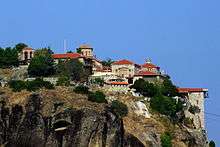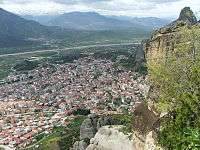Meteora
Meteora (Greek: Μετέωρα, Metéora) is one of the gems of Greece. Near the town of Kalambaka (Καλαμπάκα, Kalabáka) (Population: 21,991 (2011)) in northwestern Thessaly, it consists of a number of rock pinnacles topped with a total of 24 monasteries, 6 of which are still in use and open to visitors, while the others are abandoned.
Understand
History
Emerging about 25 million years ago as the elevated seabed material that was the outcome of strong tectonic movements, the Meteora rocks became a shelter of humankind. The first hermits arrived in this area to seek spiritual isolation and inhabited the caves of the rocks, with the sole aid of ropes and ladders.
Common existential needs and strong religious faith compelled them to live united in the first monastic communities, their common drive of faith guiding them towards the unrepeated construction of monasteries of highest architectural and artistic value.
The 24 monasteries emerged on the countless summits of the rocks from the 14th until the 16th century, 6 of them remaining to be explored and admired by all. These monasteries became the centers of the Orthodox creed in the Byzantine era, having produced some of the best pieces of religious art and craft and still possessing a collection of precious manuscripts, which today are on display in their museums.
Modern day Meteora
The Meteora monasteries have been included in the UNESCO World Heritage List and the Meteora-Antichassia region has been officially declared a Natura 2000 Ecological Zone by the Greek Ministry of Environment, for the protection of rare species of birds and flowers.
Climate
The mountain range to the east and north of the site experiences a wide climatic variation from baking heat in summer to severe cold in winter with heavy snowfalls. Summer is the driest time, storms occurring all year round especially at higher altitudes.
Information Office
- 🌍 Public Tourist Information Officce, Patriarchou Dimitriou 1.
Get in
By train
From Athens you can take either a train or a bus up to Meteora. The trains servicing the northern part of Greece leave from the "Larissa station" in Athens, while the buses serving that part of the country leave from Terminal B, at Liossion Street. Train schedules can be obtained from TrainOSE and buses usually leave once every two hours. Both rides are long (about 4.5 to 5 hours) so make sure to bring a good book. There are also train connections from Thessaloniki (about 3 hours), Volos (about 2 to 3.5 hours) and from Larissa (about 1 to 3 hours). Usually you change trains at Paleofarsalos station.
By bus
There are daily bus connections (you can see them all in English and Greek ) to/from Kalampaka from/to Trikala and Larissa. From Athens, Thessaloniki and Volos you can take the bus to either Trikala or Larissa and then take a bus to Kalampaka.
By car
The monasteries are well served by good roads and are safe and well sign posted. There are various lay-bys and free parking spaces around the area and near monasteries.
By plane
You can fly from Central Europe to Volos, Central Greece airport which is in Nea Anchialos and then travel by car for approximately two hours to Meteora. You can also take the train or bus from Volos to Kalampaka, but it will take much longer.
Get around
In 2005, you could hire a taxi right at the train station to take you to all the monasteries for about €30-40. However, reaching the spires by foot gives visitors a much more tangible feeling of the Meteora's majesty. It is a difficult hike, but experiencing the sanctuaries like the monks did a few hundred years ago only increases its wonder. In the summer, be prepared for the Greek heat, and as the hike takes a whole day, bring a few litres of water.

See
The following monasteries can be visited and are located nearby the road circuiting Meteora. Clockwise you'll find:
- 🌍 St. Nikolaos Anapafsas (Άγιος Νικόλαος Αναπαυσάς). Summer timetable: 09:30-15:30, closed on Fridays. The Holy Monastery of Saint Nikolas of Anapafsas is the first Monastery you will encounter on your way to the Meteora and was founded at the end of the 14th century. The monastery is a 1-km walk from Kastraki village. €3.
- 🌍 St. Barbara of Roussanou (Αγία Βαρβάρα Ρουσσάνου). Summer: Th-Tu 09:00-17:00; winter: Th-Tu 09:00-14:00. The Holy Monastery of Roussanou has received the name of the first probable hermit who settled on the rock. The main cathedral, celebrating the memory of Santa Barbara, was founded at the end of the 16th century and was decorated 30 years later. €3.
- 🌍 Varlaam (Βαρλαάμ). Summer: Sa-Th 09:00-16:00; winter timetable: 09:00 to 15:00. The Holy Monastery of Varlaam is the second biggest monastery. It is opposite the Great Meteoro Monastery and it was founded in the mid-14th century by the exercitant Hosios Varlaam. €3.
- 🌍 Great Meteoron (Μεγάλο Μετέωρο). Summer: W-M 09:00-17:00; winter: 09:00 to 14:00. The Holy Monastery of Great Meteoro (Transfiguration of Jesus) is the biggest and oldest one of all, dating back to the 14th century. It was called the monastery that was "suspended in the air" (meteoro), because of the formation of the gigantic rock on top of which it was built. €3.
- 🌍 Holy Trinity (Αγία Τριάδα). Summer: F-W 09:00-17:00; winter: F-W 09:00-16:00, closed on Thursdays.. The Monastery of Holy Trinity (Agia Triada) is the most difficult to reach, but once you get to the very top, the panoramic view of the surroundings is simply captivating! €3.
- 🌍 St. Stephen (Άγιος Στέφανος). Summer: Tu-Su 09:30-13:30 and 15:30-17:30; winter: 09:30-13:00 and 15:00-17:00. This is the most accessible monastery, where instead of steps you simply cross a small bridge to reach the entrance. It is ideal for visitors who cannot use the steps and yet they wish to have a real experience of a Meteora monastery. €3.
Inexpensive, mass produced icons may be purchased in the monasteries for as little as €1.
In the high season, the monasteries can become incredibly crowded with large groups virtually filling the chapels and other areas within the monasteries. If possible, visit early in the day! The monasteries were not built for tourism. Tourism, though essential to the monasteries' survival, has also destroyed their character. They are no longer contemplative.

Do
- Walk along the paths leading to the rocks and monasteries.
- Climb the rocks. There are more than 170 peaks and 600 bolted climbing routes in the area. You can buy the 2 guidebooks containing almost every route from the local bookstores. It is to be noted that there is no option for renting equipment so one should either bring his own or get a climbing guide.
- Drive the road connecting monasteries.
Eat
Kastraki has a number of restaurants, but if you are looking for a light meal, the ouzeri on the main road slightly downhill (towards Kalambaka) was excellent and cheap. Live music when the owner's friends come along at night.
- Meteora Panorama is a good choice with open wifi and view to the mountains and the valley.
Sleep
The nearby towns of Kalampaka and Kastraki both offer different kinds of accommodation. Choose Kastraki if you want to stay close to the rocks, and also for the village atmosphere.
- Dellas Boutique Hotel - meteora experience, Kalambakas - Kastrakiou Street, Kalambaka [Kastraki], Meteora | Trikala, Thessaly - Greece, ☎ +30 24320 78260, fax: +30 24315 00000, e-mail: info@dellasboutiquehotel.com. Check-in: 14:00, check-out: 12:00. This hotel is in the shade of the rocks of Meteora. from €50.
- San Giorgio Villa - meteora's budget accommodations, Kalambaka [Kastraki], Meteora | Trikala, Thessaly - Greece, ☎ +30 24320 75255, fax: +30 24315 00123, e-mail: reservations@sangiorgiovilla.com. Check-in: 14:00, check-out: 12:00. San Giorgio Villa is small budget accommodation property, the so-called "Meteora's Budget Accommodations", on the road to the holy rocks, in Kastraki village. from €35.
- Also's House, 5 Kanari St. 422 00 Kalampaka (Head towards the back of town with the footpath to Meteora. It is there alongside two other places, Elena and Koka Roka), ☎ +30 2432024097. A quality establishment at decent prices, cheaper than most places in the area. If it is not busy, price may be reduced if you don't want breakfast or AC. Great view of the rocks, free internet and Wi-Fi. Clean, comfortable, and nice. You will get your money's worth here. The owner is a great guy as well, speaking excellent English and offering good advice. single private is €35.
- Archontiko Mesohori, in Kastraki, ☎ +30 24320 77125, fax: +30 24320 77164, e-mail: info@archontikomesohori.gr. Mobile: +30 6936786418. In the old habitation of one of the most impressive picturesque villages of Greece, this old mansion of the 19th century has been renovated to become a most attractive luxury small hotel. €110 per suite.
- Theatro Hotel Odysseon, Kalampaka, ☎ +30 2432022320, fax: +30 2432075307, e-mail: info@hotelodysseon.gr. Check-in: 12:00, check-out: 12:00. Just on the foothills of Meteora with panoramic view to the rocks, you can find this charming and cheap hotel on the way from the center of the town towards Meteora and Kastraki Village just before you exit the town. 50.00 euro for a double room breakfast included.
- Hotel Rex, Patriarhou Dim St 7, ☎ +30 2432022042, e-mail: info@hotelrex.gr. 3-star hotel in Kalampaka. Don't forget to take your coffee or drink at the rooftop bar with views over the Meteora. All rooms have A/C and there is free breakfast and Internet Singles: €40, twins: €55, triples: €75.
- Toti (Totis Theano) (a few blocks off the main square, towards the Meteroa footpath in the back of town). Clean, comfortable, close to the centre of town. Some rooms have partial views of the monasteries. There been complaints about the behaviour of the owner. Double without/with breakfast from €30/45; triple with breakfast from €36.
- Tsikeli Hotel, Kastraki (Kalambaka - Thessali), ☎ +30 2432022438. Excellent hotel. Comfortable. Air condition (silent and efficient). Amazing view to the Cliff of Meteora. Warm and friendly atmosphere. the hotel provides personal care, good breakfast in a beautiful garden. Wi-Fi access. Near cafes and restaurants.
Respect
While visiting the monasteries, women are required to wear skirts covering the knees and have their shoulders covered, too. Most of the monasteries do provide wraps for women who come unprepared, but if you bring your own, especially one with bright colors, you'll get a smile from the monk or nun at the entrance.
Along the same line, men are required to wear trousers covering the knees. This too can be borrowed from the stock at the entrance but that clothing isn't washed after every user so you may not feel comfortable wearing these skirts. One size fits all for men!
Go next
- Thessaloniki, almost 3 hours by car